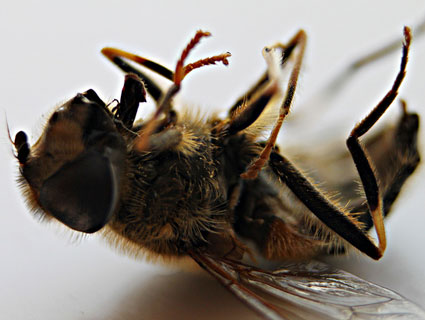 I’ve made a career of sorts writing about the “big six” agrichemical companies—Monsanto, Dow, Bayer, DuPont, Syngenta, and BASF—that produce the great bulk of the world’s pesticides and, increasingly, seeds. But last week, I did something different. Rather than investigate and critique these companies in print, I broke bread with some of their executives. And then, in a public forum live-cast on the internet from DC’s Newseum, I told them bluntly what I thought of their industry.
I’ve made a career of sorts writing about the “big six” agrichemical companies—Monsanto, Dow, Bayer, DuPont, Syngenta, and BASF—that produce the great bulk of the world’s pesticides and, increasingly, seeds. But last week, I did something different. Rather than investigate and critique these companies in print, I broke bread with some of their executives. And then, in a public forum live-cast on the internet from DC’s Newseum, I told them bluntly what I thought of their industry.
They seemed a bit stunned by the spectacle, rapt in attention but increasingly silent as my critique went on. From my perspective, I was looking into a sea of dark suits, red ties, and wide eyes, with only the stray vigorous shake of the head to register open dissent from my critique.
The event was the annual policy summit held in Washington, DC, by CropLife America, the trade group representing Big Agrichem/Biotech and the suppliers and retailers that sell their goods throughout farm country. The group had invited me to speak at the behest of my friend, green-business journalist Marc Gunther, who has an annual gig moderating the event.
My foray into agrichem-exec shoulder-rubbing began the night before the conference, when I attended the pre-event speakers’ dinner in a private dining hall of a DC hotel.
The CropLife event planners greeted me warmly when I arrived—to my delight, as one of them handed me a goodie bag, she joked, “And it’s not pesticides!” What was in there delighted me, too—a coffee mug and a baseball jersey emblazoned with CropLife’s slogan: “Modern Agriculture.”
As I pulled down my name tag and made my way into the dining hall, I quickly spied the bearded, stout figure of Bob Stallman, president of the American Farm Bureau Federation, which calls itself the “voice of agriculture” but is more accurately described as the “voice of industrial agriculture.” He is a zealous evangelist of chemical-intensive farming, preaching the virtues of GMOs, biofuels, factory-scale animal farms, and minimal regulation. I walked right up to him and shook his hand, declaring that it was great to finally meet someone whom I had been reading about for years. He accepted my greeting cordially—and seemed genuinely nonplussed as to who I was: a deflating experience.
Soon I was shuffled to a table featuring some Dow and DuPont execs and a man who owned an input supply company in the Midwest. It was a small gathering—maybe eight tables, each with around five people. The dress code was strictly business—I was one of the few men not in a dark suit and tie. Again, none of them seemed to have the foggiest idea as to who I was. The input guy and I sparred cordially through dinner about the viability of organic ag—he was open to my ideas and listened to me; I returned the favor.
How was the food? That was a major point of curiosity for me when I accepted the gig. What does the agrichemical industry eat at its feasts? Not surprisingly, fancy—and generally passable—hotel fare. The night’s menu included a reasonably fresh salad, some competently cooked mixed vegetables, and a filet mignon cooked medium. Normally I don’t eat meat whose origin is mysterious to me, but that night I was famished from travel and work. As I laid into the filet mignon, I thought of the specter of meat glue and how it’s commonly used to fabricate filet-mignon-like beef cuts in institutional settings. I remembered the vow, in my recent piece on meat glue, to “eat around” filet mignon if I’m ever—”God forbid”—served it “at some cursed banquet.” Shaking off my vow, I ate about half of it. As with all filet mignon dishes, it was tender but didn’t taste like much.
At the next day’s conference, I appeared on a panel of food bloggers, along with Danielle Gould of Food + Tech Connect and Hemi Weingarten of Fooducate. The moderator, Gunther, asked us each to describe how we got into blogging. I told of how, when I launched a food-politics blog back in 2005, my very first post was a meditation on Monsanto’s market power. I explained that in the first months of my blog, I had become so fixated on the GMO seed/agrichemical giant that I had taken to running a regular feature called Roundup Ready, “named in honor of Monsanto’s famed line of seeds genetically engineered to withstand its herbicide Roundup,” which gave a brief overview of recent news, trends, and topics in the food-politics world.
After months of diligent daily blogging, I had built up a regular national readership numbering in the low two digits. My break came when someone from Monsanto’s legal department—surely an intern, I speculated, because surely no actual company lawyer was trolling Google search to root out obscure blogs criticizing Monsanto—sent me a cease-and-desist email demanding that I stop using the phrase “Roundup Ready.”
“I knew that email was pure gold,” I told the crowd. “I knew I was a made guy after that.” I published Monsanto’s letter along with a cheeky response, generating a small internet sensation, and before long was invited to move my blog to Grist.
My story went over big. It drew cackles and guffaws as I told it; the assembled reps of the agrichemical industry seemed genuinely delighted that one of the largest companies among them had inadvertently helped launch my career.
The mood darkened considerably at other points in my remarks. Gunther asked me what role I thought I played as a blogger. I said, to explain, that we had to back up a bit. The agrichemical industry had become extremely consolidated, which meant that a vast amount of profits had become concentrated into the coffers of a handful of companies. That effect gave these companies the resources to invest millions of dollars in research and marketing. I noted a report that I had seen that very week showing Monsanto has already spent $1.4 million on lobbying in the first three months of 2012 alone.
In that context, I said, I see my work as a counterweight. I’m a journalist on the ground digging into the industry’s claims, looking critically at how its technologies play out for people and ecosystems. I pointed to the example of ubiquitous neonicotinoid pesticides and the growing weight of science linking them to declining honeybee health, as well as to the failure of Monsanto’s Roundup Ready technology and the gusher of toxic herbicides now hitting US farmland as a result. These were the kind of stories I fixate on on from my modest perch at a nonprofit publication while a steady blitz of marketing and lobbying held those very products in place.
And so it went on for a while, the room feeling both highly charged and dead silent as I spoke bluntly and from the heart.
The tension reached a dramatic crescendo during the Q&A period. A distinguished older gentleman took the mic, declared his name was Charlie Stenholm and had been a US representative from Texas for many years and was now a lobbyist—though his wife prefer he call himself an educator.(Stenholm serves as senior policy adviser to Olsson, Frank & Weeda, the powerhouse lobbying firm). How, he demanded to know in his slow and charming Texas drawl, looking me in the eye, could I possibly question GMO technology when it was so clearly needed to feed the world?
That gave me the opportunity to deliver my critique of GMOs. After 25 years of R&D and 16 years in the field, the industry has so far delivered precisely two widely used traits: herbicide resistance (Roundup Ready) and pesticide expression (Bt). The first has already failed, and the second is showing signs of coming undone. Meanwhile, the so-called complex traits—crops that use less water or nitrogen—clearly aren’t working. Moreover, despite all the “feed the world” rhetoric, GMOs have so far succeeded in boosting crop yields only marginally. GMOs have been a magnificent success in the marketplace, I declared, but what had they succeeded at? Mainly, I charged, at generating profits for a few big companies in the form of licensing fees and herbicide sales.
I have to say, it felt cathartic to face down a man who had unapologetically barreled through the revolving door between government and agribusiness.
When the panel ended, I was greeted immediately by reps from Syngenta and Dow. The Syngenta guy wanted to make sure I knew that the US regulatory system was full of rigorous scientists who vetted the industry’s products carefully and would never let something through that might harm the public. I respectfully disagreed. I also talked for a while with Jack Bobo, senior adviser for biotechnology at the State Department and a GMO booster. Bobo and I started to get into the weeds (so to speak) about crop yields and agricultural challenges in the Global South. We agreed to continue our conversation later, and now I have his business card, as well as those of a few agribiz suits.
Dialogue can only flourish amid honesty, and I delivered an honest accounting of my views directly to the agribusiness community last week. I hope the dialogue continues, and I intend to reach out to my new friends in the industry and hear what they have to say.















